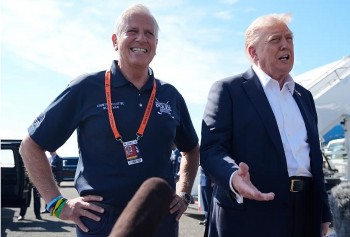How Many States Have a $15 Minimum Wage in 2025?
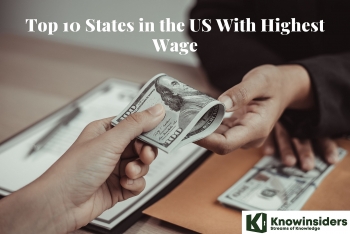 Top 10 States in America With the Highest Average Wages Top 10 States in America With the Highest Average Wages |
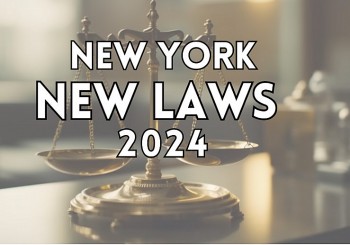 19 Most Important New Laws Taking Effect in New York 2024 19 Most Important New Laws Taking Effect in New York 2024 |
As of 2025, several states in the United States are setting their minimum wages at $15 per hour or higher. This change reflects a broader national movement to improve the financial well-being of low-wage workers and address the rising cost of living.
By 2025, 16 states will either have already implemented or be on a clear path to reaching a $15 minimum wage.
This includes seven states that had already achieved this milestone prior to 2025, three states joining in early 2025, and others planning to meet the benchmark in subsequent years.
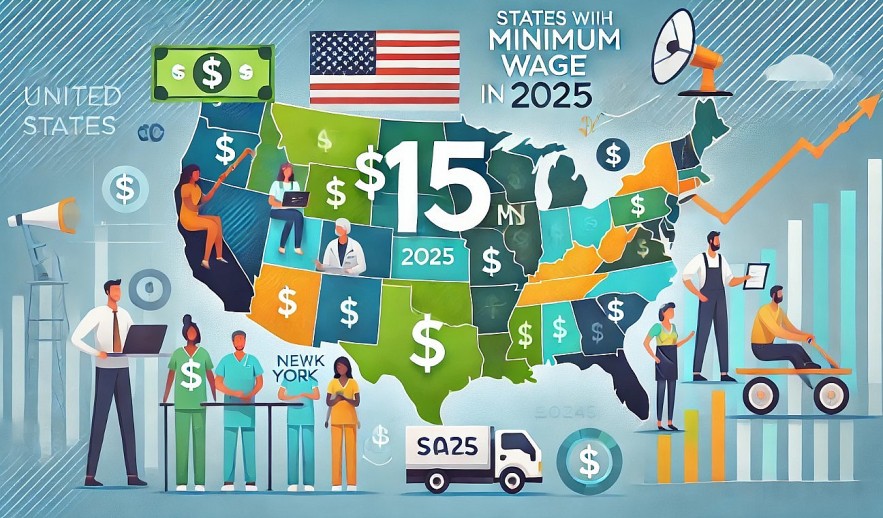 |
| What States Have a $15 Minimum Wage in 2025 |
States at $15 or Higher in 2025
The push for a $15 minimum wage began gaining traction in the 2010s, driven by campaigns like "Fight for $15." Over time, states have adopted policies to phase in increases, bringing millions of workers closer to a living wage. By 2025, the following states will be at $15 or higher:
States Already at $15 Minimum Wage Before 2025
- California: As a leader in the $15 wage movement, California set the standard with its phased-in increases, reaching $15 statewide in 2022. By 2025, certain sectors, such as healthcare, will see wages exceed $17.
- New York: Regions like New York City, Long Island, and Westchester already have $15 minimum wages, with adjustments tied to inflation in other parts of the state.
- Massachusetts: Reached $15 in 2023 as part of a multi-year increase plan.
- Maryland: Fully transitioned to $15 in 2023.
- Washington: Known for its progressive wage policies, Washington is expected to exceed $15 by 2025 due to inflation adjustments.
- Connecticut: Reached $15 in 2023 and continues to adjust for inflation.
- New Jersey: Achieved $15 in early 2024, with additional indexing for inflation starting in 2025.
States Joining the $15 Minimum Wage Club in 2025
- Illinois: Moving from $14 in 2024 to $15 on January 1, 2025.
- Rhode Island: Scheduled to reach $15 by January 1, 2025.
- Delaware: Progressing from $13.25 to $15 on January 1, 2025.
- Oregon: Expected to reach $15 in mid-2025, driven by cost-of-living adjustments.
States Approaching $15 by 2026–2027
States like Alaska, Missouri, Florida, Hawaii, and Nebraska are on trajectories to reach $15 within the next few years, with most implementing phased increases tied to inflation or legislative milestones. By 2027, nearly half of the U.S. workforce will be in states with minimum wages of $15 or higher.
Highest and Lowest State Minimum Wages in 2025In 2025, Washington, D.C. will have the highest state minimum wage, starting from $17.50 in July 2024 with another adjustment scheduled for July 2025. Among the states, the top three highest minimum wages will be in Washington ($16.66 per hour), California ($16.50 per hour), and Connecticut ($16.35 per hour). At the opposite end of the spectrum, Georgia and Wyoming have the lowest state minimum wages, set at $5.15 per hour. However, these rates are overridden by the federal minimum wage of $7.25 per hour. As of 2024, 20 states adhere to the federal minimum wage, while 30 states have established state minimum wages higher than the federal standard. |
The Broader Context of $15 Minimum Wage Policies
The minimum wage serves as a critical policy tool to ensure workers earn enough to cover basic living expenses, such as housing, food, and transportation. A $15 minimum wage is seen as a significant milestone in addressing income inequality and boosting economic security for millions of Americans.
The $15 Benchmark and Economic Justice
For many advocates, $15 represents more than just a number; it symbolizes a wage that aligns more closely with the cost of living in many parts of the country. Workers earning $15 can afford more than just basic necessities and gain the financial flexibility to contribute more to their local economies through discretionary spending.
Local Governments Leading the Way
Cities and counties often set minimum wages higher than their state mandates. In 2025:
- Burien, Washington: Poised to have the nation’s highest minimum wage at $21.16 for large employers.
- Over 40 localities in California and other progressive states will exceed $15, with some jurisdictions surpassing $17.
Economic Implications of a $15 Minimum Wage
Benefits for Workers
- Poverty Reduction: A $15 minimum wage could lift millions of workers out of poverty. According to the Economic Policy Institute, wage increases directly benefit low-wage earners while creating a ripple effect for workers earning slightly above the minimum wage.
- Increased Consumer Spending: Higher wages provide workers with more disposable income, fueling local economies and boosting demand for goods and services.
- Reduced Income Inequality: $15 helps narrow the wage gap between low-wage and high-wage workers, fostering greater economic equity.
Challenges and Criticisms
- Employment Concerns: Critics argue that higher labor costs may lead to job cuts or reduced hours, especially for small businesses and industries reliant on low-wage labor.
- Inflationary Pressures: Some economists caution that significant wage hikes could contribute to price increases in sectors like retail and dining.
- Regional Variations: A uniform $15 wage may strain businesses in rural areas with lower living costs compared to urban centers.
Federal Minimum Wage StagnationThe federal minimum wage has remained at $7.25 per hour since 2009, falling behind the pace of state and local increases. In 2025, 30 states will have minimum wages higher than the federal level, covering more than 60% of the U.S. workforce. Efforts to raise the federal wage to $15 have faced resistance in Congress, leaving the responsibility to state and local governments. |
Why $15 Matters: A Living Wage Perspective
Despite its significance, a $15 minimum wage still falls short of a true living wage in many areas. For example:
- In King County, Washington, the living wage for a single adult is $30.08, according to the MIT Living Wage Calculator. This highlights the need for continued discussions about wages and cost-of-living disparities.
Looking Ahead: The Path Beyond 2025
As more states and localities adopt $15 minimum wages, the debate over its impacts will continue. Policymakers, businesses, and workers must collaborate to address challenges while maximizing benefits. Key areas for focus include:
- Support for Small Businesses: Providing tax incentives or subsidies to help smaller employers adapt to higher labor costs.
- Inflation Adjustments: Linking wages to inflation ensures that minimum wages keep pace with rising living costs.
- Regional Strategies: Tailoring wage policies to reflect local economic conditions and living costs.
Conclusion
By 2025, 16 states will have reached a $15 minimum wage, marking a significant milestone in the fight for fair pay and economic justice. While these increases bring tangible benefits to millions of workers, they also present challenges that require thoughtful policy responses. As the United States moves closer to universal adoption of a $15 wage floor, the experiences of these states will provide valuable insights into the broader implications of wage policies and their role in shaping a more equitable economy.
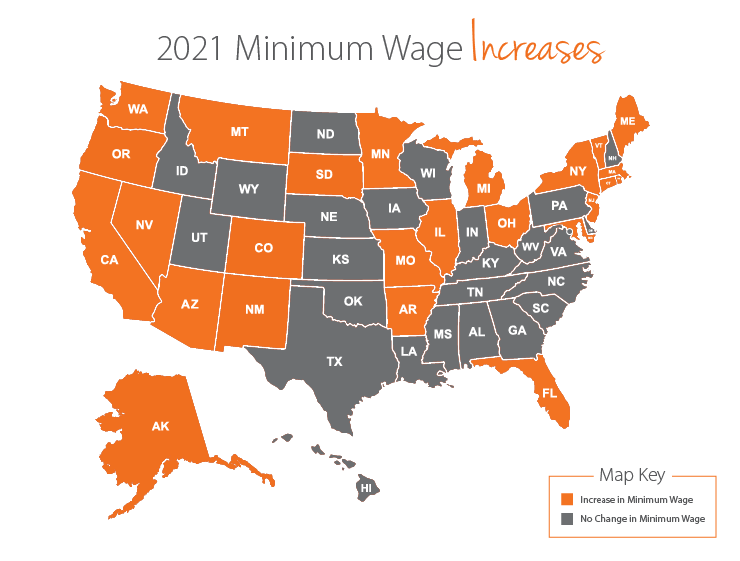 New Policy in the US in 2021: Half of U.S states will increase minimum wage New Policy in the US in 2021: Half of U.S states will increase minimum wage New U.S laws in 2021: This year, half of U.S states will increase their minimum wage some by pennies, others by a dollar or more. |
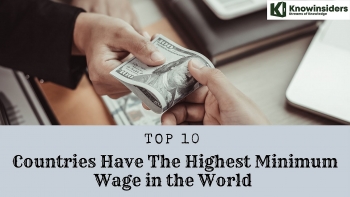 Top 10 Countries Have The Highest Minimum Wage in the World Top 10 Countries Have The Highest Minimum Wage in the World The minimum wage (salary) has a great effect on people's lives, lifestyles, and the economy of a country. Here are the top 10 countries with ... |
















